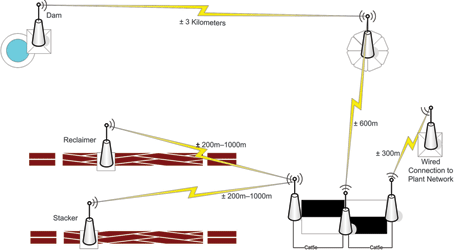
Physical media for Ethernet communications in the utility and industrial environment.
In recent years, utility and industrial sites have been moving to Ethernet networks to run automation across the site using the flexible, open standards. Ethernet allows different vendors to communicate using standards that define the way connection between devices is created, the way data is packaged for transfer between devices and how it is reassembled. Using Ethernet means that the site can be connected by a single network, allowing remote configuration and control as well as quick response times and troubleshooting of problems.
The physical medium used to transmit the data is the first building block in the Ethernet model and there is a wide variety on offer. The most commonly used are copper (Category 5e or 6) and fibre-optic cables. Copper has a maximum distance of 100 m without EMI (electro magnetic interference) protection and so is generally used within a single cabinet/building. Fibre-optic, on the other hand, can reach up to about 100 km per run between devices/repeaters, depending on the equipment and type of fibre being used, and so is more often used for linking the buildings, sites, substations or mines together.
The costs of cables and installation can be high, especially in harsh environments. In most industrial and utility installations a protected type of fibre-optic cable called ruggedised cable is used. This cable is wrapped in a protective PVC sheath which provides extra protection against elements that could damage the cable (such as exposure to the elements). When using copper cabling in substations it is necessary to use F/S/TP (foiled/shielded twisted Pair) cabling; this provides protection against EMI which can cause data loss or cause equipment failure in certain environments.
It is recommended to use one or more fibre-optic pairs to join core segments of the network; however, in some cases there may be a remote location with only one or two end devices, such as a small rural substation or an overflow dam. In these cases the cost can be extremely high to run standard copper or fibre cabling for a small number of devices, the cost of the cabling can even become higher than the cost of the devices. When this is the case cheaper alternatives are required that still provide the stability and reliability of hardened industrial or utility grade equipment.
One alternative is to use WiFi. These devices communicate using radio signals and thus have no need for physical cabling. Installing wireless involves more planning than installing cables, as site surveys are required to determine where devices will need to be installed in order to provide coverage to the correct locations. Other factors include determining if there is correct line-of-sight between antennas and scanning to find out what other devices in the area could be using the same frequencies, thus causing unwanted interference.
One example of this is a project where H3iSquared was contracted to install a WiFi solution for communication between a coal mines control room and an overflow meter at a remote dam 3 km away. Communication was also required between a stacker and reclaimer, both of which could move up to 1 km on railway tracks, to complete the interlocking of these machines to prevent collisions. H3iSquared conducted a site visit and determined that there were too many obstacles in the form of process equipment, buildings and changes in the land’s topography. These factors made it impractical to use wired communications due to the time and cost involved to run cable routes. For this reason a solution was recommended that would be part WiFi and part wired.

In this scenario there is only one IED at the remote dam that needed to be linked to the rest of the network, however this IED is critical. Prior to installing the WiFi solution, when a pump needed to be started or stopped an engineer had to be called to make a trip to the dam. With the new installation the IED at the dam can be monitored and controlled remotely, allowing engineers to be more productive.
WiFi can be a great alternative to using cabling, however it is dependent on factors like obstructions of the links and interference caused by other WiFi devices in the area. For places where WiFi is not feasible and standard Ethernet cabling is too costly, RuggedCom has developed its EoVDSL (Ethernet over VDSL) range of products. EoVDSL is a technology that can utilise single untwisted pair cabling (Such as telephone cables) to transfer Ethernet up to 4 km with bandwidths up to 40 Mbps. This allows existing cabling to be utilised, meaning installation costs are minimised. EoVDSL can also be used in areas where obstructions limit the use of WiFi devices.
Due to RuggedCom’s modular device design, many different communication methods can be combined into a single unit. For instance a unit can be built with six normal copper ports for IEDs, a wireless module for engineering access or a wireless link and an EoVDSL port to connect this remote section to the rest of the control network many kilometres away. With this kind of flexibility a unique tailored solution can be built for any end user requirements, whilst minimising the amount of different devices or even vendors required. These solutions are more reliable as they have less points of failure and it is feasible to keep a single device as a spare rather than having to worry about two or three devices per section. RuggedCom devices are built to last with a standard warranty of five years and the option to increase this to 10.
| Tel: | +27 11 454 6025 |
| Email: | [email protected] |
| www: | www.h3isquared.com |
| Articles: | More information and articles about H3iSquared |

© Technews Publishing (Pty) Ltd | All Rights Reserved